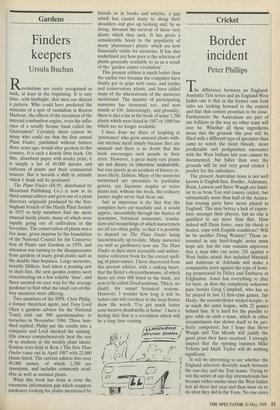Gardens
Finders keepers
Ursula Buchan
Revolutions are rarely recognised as such, at least in the beginning. It is only later, with hindsight, that men can discern a pattern. Who could have predicted the outcome of a spot of vandalism in Boston Harbour, the effects of the invention of the internal combustion engine, even the influ- ence of a scruffy Scouse band called the Quarrymen? Certainly there cannot be many who could see that the first annual Plant Finder, published without fanfare three years ago, would alter gardens in this country. It is such a dowdy little book. On thin, absorbent paper with murky print, it is simply a list of 40,000 species and cultivars of plants and their commercial sources. But it heralds a shift in attitude which I think will be profound.
The Plant Finder (£8.95, distributed by Moorland Publishing Co.) is now in its third annual edition and grew out of a plant directory originally produced by the Not- tingham branch of the Hardy Plant Society in 1975 to help members find the more unusual hardy plants, many of which were rapidly going out of cultivation in the Seventies. The conservation of plants was a live issue, given impetus by the foundation of the National Council for the Conserva- tion of Plants and Gardens in 1979, and attention was turning to the disappearance from gardens of many good plants such as the double blue hepatica. Large nurseries, notably Hilliers, had taken a pruning saw to their lists, the new garden centres were concentrating on a few reliable 'lines', and there seemed no easy way for the average gardener to find what the small out-of-the- way nurseries were offering.
Two members of the HPS, Chris Philip, a former theatrical agent, and Tony Lord (then a gardens adviser for the National Trust) sent out 500 questionnaires to nurseries in November 1986. Three hun- dred replied, Philip put the results into a computer and Lord checked the naming. (He always comprehensively beat the rest of us students at the weekly plant identi- fication tests held at Kew.) The first Plant Finder came out in April 1987 with 22,000 plants listed. The current edition lists over 40,000 names, of which 2,300 are synonyms, and includes commonly avail- able as well as unusual plants.
What this book has done is close the enormous information gap which scuppers gardeners looking for plants mentioned by friends or in books and articles, a gap which has caused many to shrug their shoulders and give up looking and, by so doing, threaten the survival of those very plants which they seek. It has given a considerable boost to the popularity of many `plantsman's plants' which are now financially viable for nurseries. It has also underlined just how poor is the selection of plants generally available to us as a result of the 'garden centre revolution'.
This present edition is much better than the earlier two because the compilers have finally got to grips with roses, and tender and conservatory plants, and have added maps of the whereabouts of the nurseries mentioned. The number of participating nurseries has increased too, and now stands at 430. Interestingly, and gloomily, there is also a list in the book of some 1,700 plants which were listed in 1987 or 1988 but which are no longer available.
I have done my share of laughing at `plantsmen' who grow unusual plants with- out intrinsic merit simply because they are unusual and there is no doubt that this book encourages such people in their error. However, a great many rare plants are not dreary or otherwise undesirable, but rare purely as an accident of history or, more likely, fashion. Many of the nurseries mentioned are specialists in particular genera, say Japanese maples or water plants and, without this book, the ordinary punter might never find them out.
Just as important is the fact that the compilers have cut manfully and, it would appear, successfully through the thicket of synonyms, botanical nonsenses, transla- tions and misspellings of which nurserymen are all too often guilty, so that it is possible to depend on The Plant Finder being taxonomically up-to-date. Many nurseries (as well as gardeners) now use The Plant Finder as their most accessible and author- itative reference book for the correct spell- ing of plant names. I have discovered from this present edition, with a sinking heart, that the florist's chrysanthemums, of which there are over 600 listed in the book, are now to be called Dendranthema. This is, no doubt, for sound botanical reasons. However, I wonder how long it will be before one will overhear at the local flower show the words 'I've got much better semi-incurve dendranths at home'. I have a feeling that that is a revolution which will be a long time coming.


































































 Previous page
Previous page